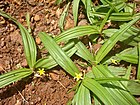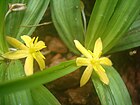Note: This is a project under development. The articles on this wiki are just being initiated and broadly incomplete. You can Help creating new pages.
Difference between revisions of "Curculigo orchioides - Black Musli"
(→References) |
|||
| (25 intermediate revisions by 2 users not shown) | |||
| Line 1: | Line 1: | ||
| − | + | [[File:Kali Musali (Marathi- काळी मुसळी) (2618279600).jpg|thumb|right|''Talamuli'', ''Curculigo orchioides | |
| + | '']] | ||
| + | '''Talamuli''' is a tiny herb that can be seen in the rainy season. They are deep rooted plants with palm like lance shaped leaves and yellow star shaped flowers. | ||
==Uses== | ==Uses== | ||
| − | {{Uses|Piles}}, {{Uses|Biliousness}}, {{Uses|Fatigue}}, {{Uses|Blood related disorders}}, {{Uses|Bronchitis}}, {{Uses|Indigestion}}, {{Uses|Vomiting}}, {{Uses|Diarrhea}}, {{Uses|Lumbago}}, {{Uses|Gonorrhea}}, {{Uses|Ophthalmia}}, {{Uses|Gleet}}, {{Uses|Hydrophobia}}. | + | {{Uses|Piles}}, {{Uses|Biliousness}}, {{Uses|Fatigue}}, {{Uses|Blood related disorders}}, {{Uses|Bronchitis}}, {{Uses|Indigestion}}, {{Uses|Vomiting}}, {{Uses|Diarrhea}}, {{Uses|Lumbago}}, {{Uses|Gonorrhea}}, {{Uses|Ophthalmia}}, {{Uses|Gleet}}, {{Uses|Hydrophobia}}, {{Uses|Osteoporosis}}, {{Uses|Skin problems}}, {{Uses|Cold}}, {{Uses|Cough}}<ref name="Karnataka Medicinal Plants"/>. |
==Parts Used== | ==Parts Used== | ||
| − | {{Parts Used|Leaves}}, {{Parts Used|Stem}}, {{Parts Used|Flowers}}, {{Parts Used| | + | {{Parts Used|Leaves}}, {{Parts Used|Stem}}, {{Parts Used|Flowers}}, {{Parts Used|Roots}}<ref name="Karnataka Medicinal Plants"/>. |
==Chemical Composition== | ==Chemical Composition== | ||
| Line 10: | Line 12: | ||
==Common names== | ==Common names== | ||
| − | {{Common names|sa= | + | {{Common names|sa=Arshoghni, Bhutali, Mausali, Musalirahi, Mushali, Talamuli, Vrishyakanda|hi=Kali-moosli, Kali-musli|kn=Nela tengu, Nelathaale gadde, Thaala moolike|ml=Nela-pana-kelangu, Nelappana-kizhanna, Nelppana, Nilappana|mr=Bhuyimaddi, Kaalimusalee|ta=Nilappanang-kizhangu, Nilavilumi, Aiyancu, Aiyancukkilankutalamuli|te=Nela-tati-gaddalu, Nelaathadi|en=Black Musli }}<ref name="Karnataka Medicinal Plants"/> |
==Properties== | ==Properties== | ||
| Line 16: | Line 18: | ||
===Dravya=== | ===Dravya=== | ||
===Rasa=== | ===Rasa=== | ||
| − | + | Madhura (Sweet), Tikta (Bitter) | |
| − | |||
===Guna=== | ===Guna=== | ||
| − | + | Guru (Heavy), Snigdha (Slimy) | |
===Veerya=== | ===Veerya=== | ||
| − | + | Ushna (Hot) | |
===Vipaka=== | ===Vipaka=== | ||
===Karma=== | ===Karma=== | ||
| − | + | Vata, Pitta | |
===Prabhava=== | ===Prabhava=== | ||
==Habit== | ==Habit== | ||
| − | {{Habit|}} | + | {{Habit|herb}} |
==Identification== | ==Identification== | ||
===Leaf=== | ===Leaf=== | ||
| − | {{Leaf|||}}<ref name="Leaf"/> | + | {{Leaf|Simple|Rosette|rhizome to 15 cm long, oblong, perennial. Leaves 10-15 x 2 cm, lanceolate, plicate, base sheathing, pilose, subsessile.}}<ref name="Leaf"/> |
===Flower=== | ===Flower=== | ||
| − | {{Flower||||}} | + | {{Flower|Bisexual|Solitary|Yellow|6|Flowering and fruiting is from January to September}} |
===Fruit=== | ===Fruit=== | ||
| − | {{Fruit|||| | + | {{Fruit||||Fruit baccate; seeds subglobose.|}} |
===Other features=== | ===Other features=== | ||
==List of Ayurvedic medicine in which the herb is used== | ==List of Ayurvedic medicine in which the herb is used== | ||
| + | * [[Musli khadiradi kashaya]] | ||
| + | <ref name="Ayurvedic properties"/> | ||
==Where to get the saplings== | ==Where to get the saplings== | ||
==Mode of Propagation== | ==Mode of Propagation== | ||
| − | {{Propagation|}} | + | {{Propagation|Tuber segment}} |
==How to plant/cultivate== | ==How to plant/cultivate== | ||
| + | Tuber segments of 1.5–2 cm size, containing the apical bud, are collected during February–March and used for propagation. <ref name="Cultivation details"/> | ||
==Commonly seen growing in areas== | ==Commonly seen growing in areas== | ||
| − | {{Commonly seen|}} | + | {{Commonly seen|Tropical area}} |
| − | |||
==Photo Gallery== | ==Photo Gallery== | ||
<gallery class="left" caption="" widths="140px" heights="140px"> | <gallery class="left" caption="" widths="140px" heights="140px"> | ||
| + | File:നിലപ്പന ചെടികൾ.JPG | ||
| + | File:Masalkamdo (Konkani- मसळकांदो) (4695538688).jpg | ||
| + | File:Talamuli (Telugu- తాలమూలి) (3665334378).jpg | ||
| + | File:നിലപ്പന 1.JPG | ||
| + | |||
| + | |||
</gallery> | </gallery> | ||
| Line 63: | Line 72: | ||
<references> | <references> | ||
| − | <ref name="chemical composition">[" | + | <ref name="chemical composition">[Chemistry]</ref> |
| + | <ref name="Ayurvedic properties">[https://easyayurveda.com/2017/08/09/black-musli-curculigo-orchioides/ Ayurvedic properties]</ref> | ||
| + | |||
| + | <ref name="Leaf">Flowering plants of Kerals vesrion-2, N. Sasidharan</ref> | ||
| − | <ref name=" | + | <ref name="Cultivation details">[http://vikaspedia.in/agriculture/crop-production/package-of-practices/medicinal-and-aromatic-plants/curculigo-orchioides Cultivation details]</ref> |
| − | <ref name=" | + | <ref name="Karnataka Medicinal Plants">”Karnataka Medicinal Plants Volume-3” by Dr.M. R. Gurudeva, Page No.723, Published by Divyachandra Prakashana, #6/7, Kaalika Soudha, Balepete cross, Bengaluru</ref> |
</references> | </references> | ||
==External Links== | ==External Links== | ||
| − | * [ ] | + | * [https://hort.purdue.edu/newcrop/CropFactSheets/kali.html Curculigo orchioides on purdue.edu] |
| − | * [ ] | + | * [https://www.ncbi.nlm.nih.gov/pubmed/20619136 Curculigo orchioides on ncbi.govt] |
| − | * [ ] | + | * [https://www.ncbi.nlm.nih.gov/pubmed/23562803 Curculigo orchioides on ncbi.govt] |
| + | * [https://pfaf.org/user/Plant.aspx?LatinName=Curculigo+orchioides Curculigo orchioides on pfaf.org] | ||
[[Category:Herbs]] | [[Category:Herbs]] | ||
| + | [[Category:Ayurvedic herbs that don't have seed photos]] | ||
| + | [[Category:Hypoxidaceae]] | ||
Latest revision as of 17:48, 21 January 2022
Talamuli is a tiny herb that can be seen in the rainy season. They are deep rooted plants with palm like lance shaped leaves and yellow star shaped flowers.
Contents
- 1 Uses
- 2 Parts Used
- 3 Chemical Composition
- 4 Common names
- 5 Properties
- 6 Habit
- 7 Identification
- 8 List of Ayurvedic medicine in which the herb is used
- 9 Where to get the saplings
- 10 Mode of Propagation
- 11 How to plant/cultivate
- 12 Commonly seen growing in areas
- 13 Photo Gallery
- 14 References
- 15 External Links
Uses
Piles, Biliousness, Fatigue, Blood related disorders, Bronchitis, Indigestion, Vomiting, Diarrhea, Lumbago, Gonorrhea, Ophthalmia, Gleet, Hydrophobia, Osteoporosis, Skin problems, Cold, Cough[1].
Parts Used
Leaves, Stem, Flowers, Roots[1].
Chemical Composition
Common names
| Language | Common name |
|---|---|
| Kannada | Nela tengu, Nelathaale gadde, Thaala moolike |
| Hindi | Kali-moosli, Kali-musli |
| Malayalam | Nela-pana-kelangu, Nelappana-kizhanna, Nelppana, Nilappana |
| Tamil | Nilappanang-kizhangu, Nilavilumi, Aiyancu, Aiyancukkilankutalamuli |
| Telugu | Nela-tati-gaddalu, Nelaathadi |
| Marathi | Bhuyimaddi, Kaalimusalee |
| Gujarathi | NA |
| Punjabi | NA |
| Kashmiri | NA |
| Sanskrit | Arshoghni, Bhutali, Mausali, Musalirahi, Mushali, Talamuli, Vrishyakanda |
| English | Black Musli |
Properties
Reference: Dravya - Substance, Rasa - Taste, Guna - Qualities, Veerya - Potency, Vipaka - Post-digesion effect, Karma - Pharmacological activity, Prabhava - Therepeutics.
Dravya
Rasa
Madhura (Sweet), Tikta (Bitter)
Guna
Guru (Heavy), Snigdha (Slimy)
Veerya
Ushna (Hot)
Vipaka
Karma
Vata, Pitta
Prabhava
Habit
Identification
Leaf
| Kind | Shape | Feature |
|---|---|---|
| Simple | Rosette | rhizome to 15 cm long, oblong, perennial. Leaves 10-15 x 2 cm, lanceolate, plicate, base sheathing, pilose, subsessile. |
Flower
| Type | Size | Color and composition | Stamen | More information |
|---|---|---|---|---|
| Bisexual | Solitary | Yellow | 6 | Flowering and fruiting is from January to September |
Fruit
| Type | Size | Mass | Appearance | Seeds | More information |
|---|---|---|---|---|---|
| Fruit baccate; seeds subglobose. | {{{6}}} |
Other features
List of Ayurvedic medicine in which the herb is used
Where to get the saplings
Mode of Propagation
How to plant/cultivate
Tuber segments of 1.5–2 cm size, containing the apical bud, are collected during February–March and used for propagation. [5]
Commonly seen growing in areas
Photo Gallery
References
- ↑ 1.0 1.1 1.2 ”Karnataka Medicinal Plants Volume-3” by Dr.M. R. Gurudeva, Page No.723, Published by Divyachandra Prakashana, #6/7, Kaalika Soudha, Balepete cross, Bengaluru
- ↑ [Chemistry]
- ↑ Flowering plants of Kerals vesrion-2, N. Sasidharan
- ↑ Ayurvedic properties
- ↑ Cultivation details
External Links
- Ayurvedic Herbs known to be helpful to treat Piles
- Ayurvedic Herbs known to be helpful to treat Biliousness
- Ayurvedic Herbs known to be helpful to treat Fatigue
- Ayurvedic Herbs known to be helpful to treat Blood related disorders
- Ayurvedic Herbs known to be helpful to treat Bronchitis
- Ayurvedic Herbs known to be helpful to treat Indigestion
- Ayurvedic Herbs known to be helpful to treat Vomiting
- Ayurvedic Herbs known to be helpful to treat Diarrhea
- Ayurvedic Herbs known to be helpful to treat Lumbago
- Ayurvedic Herbs known to be helpful to treat Gonorrhea
- Ayurvedic Herbs known to be helpful to treat Ophthalmia
- Ayurvedic Herbs known to be helpful to treat Gleet
- Ayurvedic Herbs known to be helpful to treat Hydrophobia
- Ayurvedic Herbs known to be helpful to treat Osteoporosis
- Ayurvedic Herbs known to be helpful to treat Skin problems
- Ayurvedic Herbs known to be helpful to treat Cold
- Ayurvedic Herbs known to be helpful to treat Cough
- Herbs with Leaves used in medicine
- Herbs with Stem used in medicine
- Herbs with Flowers used in medicine
- Herbs with Roots used in medicine
- Herbs with common name in Kannada
- Herbs with common name in Hindi
- Herbs with common name in Malayalam
- Herbs with common name in Tamil
- Herbs with common name in Telugu
- Herbs with common name in Marathi
- Herbs with common name in Sanskrit
- Herbs with common name in English
- Habit - herb
- Index of Plants which can be propagated by Tuber segment
- Herbs that are commonly seen in the region of Tropical area
- Herbs
- Ayurvedic herbs that don't have seed photos
- Hypoxidaceae




